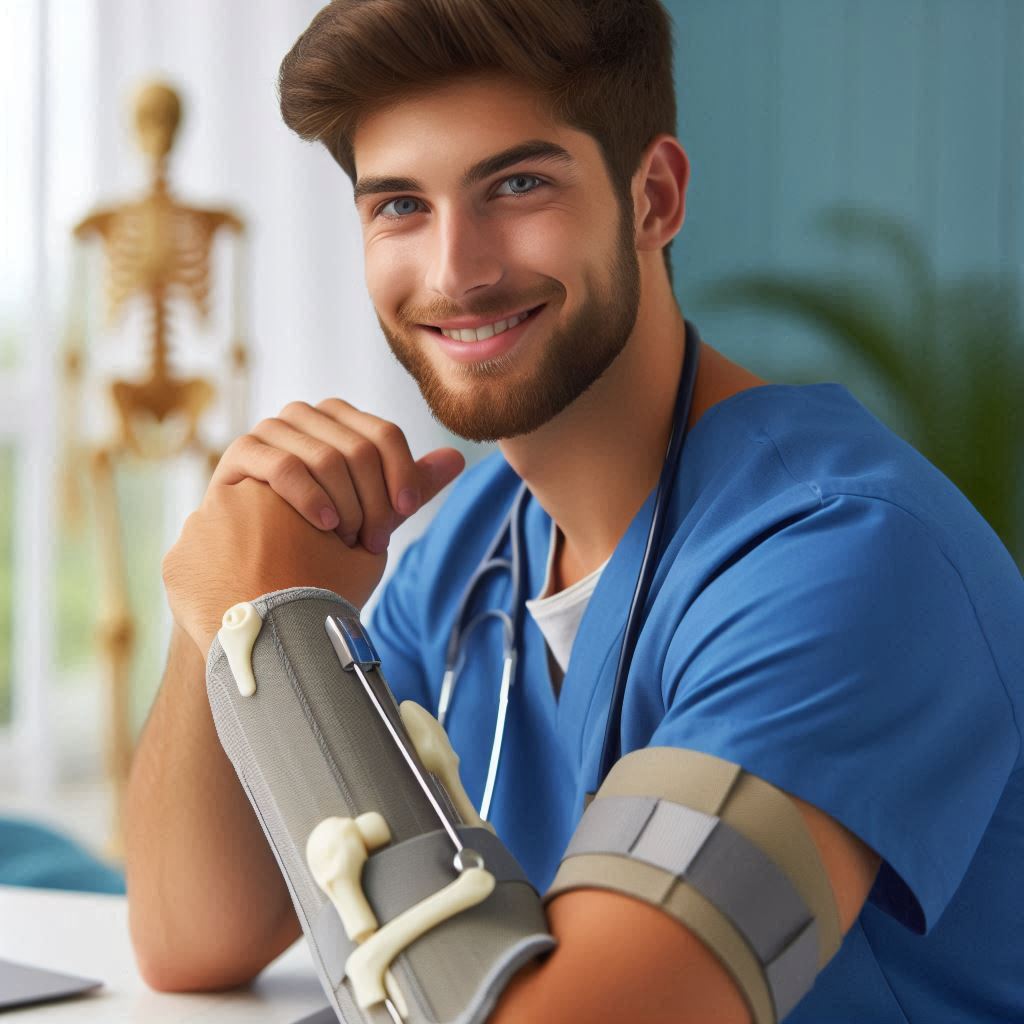Introduction
In this blog post, we will explore How Orthotists Prosthetists Improve Quality of Life for Patients.
Orthotists and prosthetists are healthcare professionals specializing in creating supportive devices.
Orthotists design and fit orthotic devices to support and correct physical function. Prosthetists craft and fit artificial limbs for those who have lost limbs.
Both roles are vital in restoring mobility and independence for patients.
Orthotists assess patient needs and create braces and other devices to aid movement.
These devices help correct deformities, alleviate pain, and support weakened muscles.
Prosthetists design and fit prosthetic limbs, enabling patients to perform daily activities and maintain their lifestyles.
Their work includes custom fitting and ongoing adjustments to ensure comfort and functionality.
The impact of orthotists and prosthetists on quality of life is significant.
They enable patients to regain independence, enhancing their physical and emotional well-being.
Custom devices help patients perform tasks they otherwise couldn’t, from walking to participating in sports.
These professionals play a crucial role in rehabilitation and recovery, offering hope and improved outcomes.
The work of orthotists and prosthetists is essential in healthcare. They provide solutions that improve mobility, reduce pain, and enhance quality of life.
Their expertise and compassion make a profound difference in the lives of those they serve.
In essence, orthotists and prosthetists empower patients to lead fuller, more active lives, showcasing the importance of their specialized roles in healthcare.
Assessing patient needs
How orthotists/prosthetists work closely with patients to assess their individual needs
Orthotists and prosthetists work closely with patients to assess their individual needs.
They begin by conducting thorough consultations, discussing the patient’s medical history, and understanding their specific goals.
This collaborative approach ensures that the patient’s voice is heard and their unique circumstances are considered.
The process of evaluating the patient’s physical condition and lifestyle
The process of evaluating a patient’s physical condition and lifestyle is meticulous.
Orthotists and prosthetists perform physical examinations to gauge the patient’s mobility, strength, and range of motion.
Transform Your Career Today
Unlock a personalized career strategy that drives real results. Get tailored advice and a roadmap designed just for you.
Start NowThey also consider the patient’s daily activities and environment.
This evaluation helps in identifying any challenges that the patient may face with a particular device.
Importance of comprehensive assessments in determining the appropriate orthotic or prosthetic device
A comprehensive assessment is crucial in determining the appropriate orthotic or prosthetic device.
It enables the practitioner to customize the device to fit the patient’s body perfectly and meet their functional needs.
This tailored approach enhances comfort, usability, and overall effectiveness.
Accurate assessments can prevent complications and ensure the device improves the patient’s quality of life.
By understanding each patient’s physical and lifestyle needs, orthotists and prosthetists can design devices that offer the best possible support and functionality.
This personalized care approach is vital for achieving positive outcomes and patient satisfaction.
Read: Orthotist/Prosthetist Success Stories: Inspiring Journeys
Customizing orthotic/prosthetic devices
When it comes to improving the quality of life for patients, orthotists/prosthetists play a crucial role in customizing orthotic/prosthetic devices tailored to each individual’s specific needs.
The process of creating custom-fit devices involves several important steps that are vital in ensuring optimal functionality and comfort for the patient.
Importance of ensuring a proper fit
Ensuring a proper fit for orthotic/prosthetic devices is essential for maximizing their effectiveness.
A device that fits well not only offers better support and stability but also enhances the overall comfort level of the patient.
Proper fit can prevent skin irritation, discomfort, and other potential complications that may arise from poorly-fitted devices.
Process of creating custom-fit devices
- Evaluation: The first step in creating custom-fit orthotic/prosthetic devices involves a thorough evaluation of the patient’s condition, needs, and limitations.
This evaluation helps orthotists/prosthetists determine the most suitable design and materials for the device. - Measurement: Precise measurements are taken to ensure the device fits the patient perfectly.
This may involve taking measurements of the affected body part, assessing any anatomical irregularities, and considering factors like weight distribution and alignment. - Design: Based on the evaluation and measurements, orthotists/prosthetists design a custom-fit device that meets the unique requirements of the patient.
The design may involve selecting appropriate materials, components, and technologies to enhance functionality and comfort. - Fabrication: Once the design is finalized, the fabrication process begins. Orthotists/prosthetists use specialized tools, equipment, and techniques to create the custom-fit device according to the specifications.
This may involve cutting, shaping, molding, and assembling various components to achieve the desired outcome.
Materials and technologies used in fabrication
The fabrication of orthotic/prosthetic devices involves the use of a wide range of materials and technologies to ensure durability, flexibility, and comfort.
Some of the common materials and technologies used in the fabrication process include:
- Carbon fiber: Known for its lightweight and high-strength properties, carbon fiber is often used in the fabrication of prosthetic limbs and orthotic braces.
- Silicone: Silicone is a popular choice for creating comfortable padding and liners for orthotic/prosthetic devices.
It provides cushioning, shock absorption, and skin protection. - 3D printing: 3D printing technology is revolutionizing the fabrication of custom-fit orthotic/prosthetic devices.
It allows for precise, intricate designs that are tailored to each patient’s needs. - Thermoplastics: Thermoplastics are commonly used in the fabrication of orthotic/prosthetic devices due to their moldable and customizable nature.
They can be heated and shaped to create a perfect fit for the patient.
In fact, customizing orthotic/prosthetic devices is a critical aspect of improving the quality of life for patients.
Orthotists/prosthetists ensure proper fit, evaluate meticulously, measure precisely, and use advanced materials and technologies.
They enhance device functionality and comfort, benefiting patient well-being.
Read: Global Opportunities for Orthotists/Prosthetists: Working Abroad
Transform Your Career Today
Unlock a personalized career strategy that drives real results. Get tailored advice and a roadmap designed just for you.
Start NowProviding ongoing support and adjustments
Orthotists and prosthetists actively enhance patient quality of life. They continuously support and adjust devices for successful patient adaptation.
Let’s delve into the key aspects of this essential service:
Role of orthotists/prosthetists in providing ongoing support and follow-up care to patients
Orthotists and prosthetists are not just responsible for fitting patients with the right devices; they also provide continuous support and follow-up care.
This includes monitoring the functionality of the devices, tracking the progress of the patients, and addressing any concerns or questions they may have.
This ongoing support is crucial in helping patients transition to their new devices smoothly and ensuring that they are getting the maximum benefit from them.
Orthotists and prosthetists answer questions and guide patients, boosting their confidence. This support helps patients navigate daily life with their devices.
Importance of Regular Adjustments and Maintenance
Orthotic and prosthetic devices are not one-size-fits-all solutions. Each patient is unique, and their needs may change over time.
That’s why regular adjustments and maintenance of orthotic/prosthetic devices are essential to ensure their optimal functionality and comfort.
Orthotists and prosthetists work closely with patients to identify any areas that need adjustment and make the necessary changes to accommodate their evolving needs.
Prosthetic limb specialists modify fit; orthotic brace experts adjust alignment. They ensure devices meet patient needs precisely.
Helping Patients Adapt to Their Devices and Address Issues
Adjusting to a new orthotic or prosthetic device can be challenging for many patients.
Orthotists and prosthetists help patients navigate this transition period by providing personalized guidance and support.
They educate patients on how to use and care for their devices, offer tips for improving comfort and functionality, and address any issues that may arise during the adaptation process.
For example, a patient who is learning to walk with a new prosthetic leg may experience discomfort or difficulty with the fit.
An orthotist or prosthetist adjusts devices, improves strength, balance through exercises, and provides emotional support to overcome challenges.
In short, orthotists and prosthetists go above and beyond simply fitting patients with orthotic or prosthetic devices.
They provide ongoing support, regular adjustments, and personalized care to help patients adapt to their devices and improve their quality of life.
Their dedication and expertise make a significant difference in the lives of those who rely on these essential medical devices.
Read: Orthotist/Prosthetist Ethical Considerations and Patient Privacy

Improving mobility and independence
Orthotists and prosthetists play a crucial role in helping patients regain mobility and independence through the use of orthotic and prosthetic devices.
Transform Your Career Today
Unlock a personalized career strategy that drives real results. Get tailored advice and a roadmap designed just for you.
Start NowThese devices are custom-made to fit each patient’s unique needs and effectively support and enhance their ability to move and perform daily activities.
How orthotic/prosthetic devices help patients regain mobility and independence
- Provide support and stability: Orthotic devices such as braces are designed to provide support to weakened or injured body parts, allowing patients to move more comfortably and safely.
- Correct alignment: Prosthetic limbs are created to align with the patient’s natural body structure, facilitating a more natural gait and movement patterns.
- Compensate for lost function: Prosthetic devices can compensate for lost limbs or impaired function, enabling patients to perform tasks they were unable to do before.
- Enhance balance and coordination: Orthotic devices can assist patients in maintaining balance and coordination, reducing the risk of falls and injuries.
Success stories of patients who have benefited from orthotic/prosthetic interventions
Many patients have experienced significant improvements in their quality of life as a result of orthotic and prosthetic interventions.
Here are some inspiring success stories:
- John, a veteran who lost his leg in combat, can now walk independently with the help of a prosthetic limb, allowing him to lead an active lifestyle.
- Sarah, who suffered from a spinal cord injury, regained her mobility and independence with the use of a customized orthotic brace that supported her spine and helped her stand and walk.
- Mark, a young athlete who injured his knee, returned to his favorite sport after receiving a custom knee brace that provided the necessary support and stability for him to compete again.
The impact of improved mobility on overall quality of life for patients
Improved mobility not only enhances physical well-being but also has a positive impact on the overall quality of life for patients. Here’s how:
- Increased independence: With improved mobility, patients can perform daily tasks on their own, reducing their reliance on caregivers and boosting their confidence.
- Enhanced social participation: Patients with better mobility are more likely to engage in social activities, leading to improved mental well-being and a sense of belonging.
- Better physical health: Improved mobility and increased activity levels contribute to better physical health outcomes, such as reduced risk of cardiovascular diseases and obesity.
- Greater overall satisfaction: Patients who regain their mobility through orthotic and prosthetic interventions experience a higher level of satisfaction with their lives and a more positive outlook on the future.
Orthotists and prosthetists enhance life quality, restoring mobility and independence with custom devices.
Read: Volunteer Opportunities for Aspiring Orthotists/Prosthetists
Collaborating with healthcare professionals
The work of orthotists/prosthetists is not done in isolation, but rather through collaboration and teamwork with other healthcare providers.
This collaborative nature of their work plays a crucial role in ensuring the best outcomes for patients.
Collaborative nature of orthotists/prosthetists’ work with other healthcare providers
Orthotists and prosthetists work closely with physicians, physical therapists, occupational therapists, and other healthcare professionals to provide comprehensive care for patients.
They collaborate on treatment plans, share valuable insights, and work together to improve the quality of life for patients.
How teamwork among healthcare professionals leads to comprehensive care for patients
Orthotists and prosthetists provide holistic care through teamwork. They address patients’ physical, emotional, and psychological needs effectively.
This teamwork approach allows for a more comprehensive treatment plan that takes into account various aspects of the patient’s well-being.
Importance of communication and coordination among healthcare teams to ensure the best outcomes for patients
Effective communication and coordination among healthcare teams are essential for providing high-quality care to patients.
Orthotists and prosthetists communicate with other professionals to share information, discuss patient progress, and make necessary adjustments to treatment plans.
This coordinated effort ensures that the patient’s needs are met and that they receive the best possible care.
Advocating for Patient Needs
Orthotists/prosthetists play a crucial role in advocating for their patients’ needs within the healthcare system.
Patients often struggle to access orthotic/prosthetic care. Orthotic/prosthetic professionals must effectively navigate these barriers.
Ensuring patients receive the care they need is essential.
How Orthotists/Prosthetists Advocate for Patients
These healthcare providers act as strong advocates for their patients by communicating their needs, concerns, and preferences to other members of the healthcare team.
They collaborate with physicians, therapists, and insurers to ensure that their patients’ needs are met.
Transform Your Career Today
Unlock a personalized career strategy that drives real results. Get tailored advice and a roadmap designed just for you.
Start NowOrthotists/prosthetists advocate by staying updated on field developments.
They push for technology advancements to enhance treatment options. They strive to improve their patients’ quality of life.
Challenges Patients May Face
- Financial constraints: Many patients struggle with the high costs associated with orthotic/prosthetic devices and may not have adequate insurance coverage.
- Lack of awareness: Some patients may not be aware of the benefits of orthotic/prosthetic care or may not know how to access these services.
- Long waiting periods: Due to high demand and limited resources, patients may face long waiting periods to receive orthotic/prosthetic care.
- Limited access in rural areas: Patients in rural areas may have limited access to orthotists/prosthetists, creating barriers to care.
Strategies for Overcoming Barriers
- Financial assistance programs: Orthotists/prosthetists can help patients explore financial assistance programs, insurance coverage options, and alternative funding sources to make care more affordable.
- Educational outreach: These professionals can engage in educational outreach programs to raise awareness about the benefits of orthotic/prosthetic care and help patients navigate the healthcare system.
- Telehealth services: Utilizing telehealth services can help bridge the gap for patients in remote areas by providing virtual consultations and follow-up care.
- Collaboration with community resources: Orthotists/prosthetists can collaborate with community resources and organizations to improve access to care for underserved populations.
By advocating for their patients’ needs and actively working to overcome barriers to care, orthotists/prosthetists play a vital role in improving the quality of life for individuals in need of orthotic/prosthetic services.
Conclusion
Orthotists/prosthetists play a crucial role in enhancing the quality of life for their patients.
They provide custom devices tailored to individual needs, improving mobility and comfort.
Additionally, orthotists/prosthetists offer ongoing support and adjustments to ensure optimal functionality for patients.
Their expertise and compassion contribute to the overall well-being of those in need.
It is important to recognize the significant impact of orthotic/prosthetic care on the physical and emotional health of patients.
By seeking help from orthotists/prosthetists, individuals can regain independence and confidence in their daily activities.
Ultimately, the dedication and commitment of these professionals are essential in helping patients achieve a better quality of life.
Readers are encouraged to consider the transformative effects of orthotic/prosthetic care on the lives of those facing mobility challenges.




